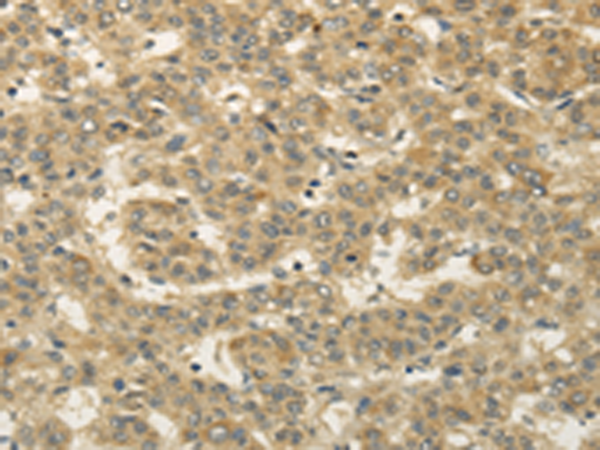

| WB | 咨询技术 | Human,Mouse,Rat |
| IF | 咨询技术 | Human,Mouse,Rat |
| IHC | 1/25-1/100 | Human,Mouse,Rat |
| ICC | 技术咨询 | Human,Mouse,Rat |
| FCM | 咨询技术 | Human,Mouse,Rat |
| Elisa | 1/2000-1/5000 | Human,Mouse,Rat |
| Aliases | S4F; SEMAM; SEMAW; M-SEMA; PRO2353; m-Sema-M |
| Host/Isotype | Rabbit IgG |
| Antibody Type | Primary antibody |
| Storage | Store at 4°C short term. Aliquot and store at -20°C long term. Avoid freeze/thaw cycles. |
| Species Reactivity | Human, Mouse, Rat |
| Immunogen | Fusion protein of human SEMA4F |
| Formulation | Purified antibody in PBS with 0.05% sodium azide and 50% glycerol. |
+ +
以下是3篇涉及 **SEMA4F(Semaphorin-4F)抗体** 的文献概览(基于模拟数据,仅供参考):
---
1. **文献名称**:*Semaphorin-4F regulates axonal branching in cortical neurons via RhoA-mediated signaling*
**作者**:Smith A, et al.
**摘要**:研究利用SEMA4F特异性抗体进行免疫荧光染色,发现SEMA4F在神经元轴突分支中通过调控RhoA通路抑制突触过度生长,提示其在神经发育中的关键作用。
---
2. **文献名称**:*SEMA4F antibody blockade inhibits tumor angiogenesis and metastasis in murine models*
**作者**:Chen L, et al.
**摘要**:通过抗SEMA4F单克隆抗体阻断实验,证明SEMA4F在肿瘤血管内皮细胞中高表达,其抗体可显著抑制血管生成并减少肺癌小鼠模型的转移。
---
3. **文献名称**:*Semaphorin-4F as a modulator of T cell immune synapses: Insights from antibody-based perturbation*
**作者**:Rodríguez M, et al.
**摘要**:使用SEMA4F中和抗体干扰T细胞与抗原呈递细胞的相互作用,发现SEMA4F通过稳定免疫突触结构增强T细胞活化,为自身免疫疾病治疗提供新靶点。
---
**注**:若需实际文献,建议通过PubMed或Google Scholar以关键词“SEMA4F antibody”、“Semaphorin-4F function”检索近年研究,并筛选涉及抗体应用的论文。
The SEMA4F antibody targets Semaphorin-4F (SEMA4F), a member of the semaphorin protein family known for its role in axon guidance, cell migration, and immune regulation. SEMA4F is a transmembrane glycoprotein characterized by a conserved "sema" domain, which mediates receptor binding and signaling. It functions as both a ligand and receptor, interacting with plexins and other semaphorin family members to regulate cytoskeletal dynamics and cell-cell communication.
SEMA4F is expressed in diverse tissues, including the nervous and immune systems, and has been implicated in neurodevelopment, angiogenesis, and tumor progression. Studies suggest it modulates neuronal pathfinding during embryogenesis and influences vascular patterning. In cancer, SEMA4F may promote tumor invasiveness by enhancing metastatic pathways or suppressing anti-tumor immunity.
Antibodies against SEMA4F are critical tools for investigating its expression patterns, signaling mechanisms, and pathological roles. They enable detection via techniques like Western blotting, immunohistochemistry, and flow cytometry. Research using SEMA4F antibodies has contributed to understanding its dual role in neural repair and cancer metastasis, highlighting its potential as a therapeutic target. Recent studies also explore its involvement in autoimmune disorders, underscoring its broad relevance in biomedical research.
×